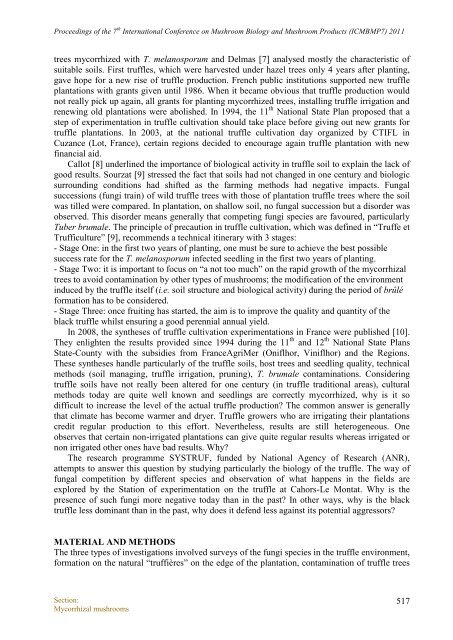BLACK TRUFFLE CULTIVATION AND COMPETING FUNGI - Inra
BLACK TRUFFLE CULTIVATION AND COMPETING FUNGI - Inra
BLACK TRUFFLE CULTIVATION AND COMPETING FUNGI - Inra
You also want an ePaper? Increase the reach of your titles
YUMPU automatically turns print PDFs into web optimized ePapers that Google loves.
Proceedings of the 7 th International Conference on Mushroom Biology and Mushroom Products (ICMBMP7) 2011<br />
trees mycorrhized with T. melanosporum and Delmas [7] analysed mostly the characteristic of<br />
suitable soils. First truffles, which were harvested under hazel trees only 4 years after planting,<br />
gave hope for a new rise of truffle production. French public institutions supported new truffle<br />
plantations with grants given until 1986. When it became obvious that truffle production would<br />
not really pick up again, all grants for planting mycorrhized trees, installing truffle irrigation and<br />
renewing old plantations were abolished. In 1994, the 11 th National State Plan proposed that a<br />
step of experimentation in truffle cultivation should take place before giving out new grants for<br />
truffle plantations. In 2003, at the national truffle cultivation day organized by CTIFL in<br />
Cuzance (Lot, France), certain regions decided to encourage again truffle plantation with new<br />
financial aid.<br />
Callot [8] underlined the importance of biological activity in truffle soil to explain the lack of<br />
good results. Sourzat [9] stressed the fact that soils had not changed in one century and biologic<br />
surrounding conditions had shifted as the farming methods had negative impacts. Fungal<br />
successions (fungi train) of wild truffle trees with those of plantation truffle trees where the soil<br />
was tilled were compared. In plantation, on shallow soil, no fungal succession but a disorder was<br />
observed. This disorder means generally that competing fungi species are favoured, particularly<br />
Tuber brumale. The principle of precaution in truffle cultivation, which was defined in “Truffe et<br />
Trufficulture” [9], recommends a technical itinerary with 3 stages:<br />
- Stage One: in the first two years of planting, one must be sure to achieve the best possible<br />
success rate for the T. melanosporum infected seedling in the first two years of planting.<br />
- Stage Two: it is important to focus on “a not too much” on the rapid growth of the mycorrhizal<br />
trees to avoid contamination by other types of mushrooms; the modification of the environment<br />
induced by the truffle itself (i.e. soil structure and biological activity) during the period of brûlé<br />
formation has to be considered.<br />
- Stage Three: once fruiting has started, the aim is to improve the quality and quantity of the<br />
black truffle whilst ensuring a good perennial annual yield.<br />
In 2008, the syntheses of truffle cultivation experimentations in France were published [10].<br />
They enlighten the results provided since 1994 during the 11 th and 12 th National State Plans<br />
State-County with the subsidies from FranceAgriMer (Oniflhor, Viniflhor) and the Regions.<br />
These syntheses handle particularly of the truffle soils, host trees and seedling quality, technical<br />
methods (soil managing, truffle irrigation, pruning), T. brumale contaminations. Considering<br />
truffle soils have not really been altered for one century (in truffle traditional areas), cultural<br />
methods today are quite well known and seedlings are correctly mycorrhized, why is it so<br />
difficult to increase the level of the actual truffle production? The common answer is generally<br />
that climate has become warmer and dryer. Truffle growers who are irrigating their plantations<br />
credit regular production to this effort. Nevertheless, results are still heterogeneous. One<br />
observes that certain non-irrigated plantations can give quite regular results whereas irrigated or<br />
non irrigated other ones have bad results. Why?<br />
The research programme SYSTRUF, funded by National Agency of Research (ANR),<br />
attempts to answer this question by studying particularly the biology of the truffle. The way of<br />
fungal competition by different species and observation of what happens in the fields are<br />
explored by the Station of experimentation on the truffle at Cahors-Le Montat. Why is the<br />
presence of such fungi more negative today than in the past? In other ways, why is the black<br />
truffle less dominant than in the past, why does it defend less against its potential aggressors?<br />
MATERIAL <strong>AND</strong> METHODS<br />
The three types of investigations involved surveys of the fungi species in the truffle environment,<br />
formation on the natural “truffières” on the edge of the plantation, contamination of truffle trees<br />
Section:<br />
Mycorrhizal mushrooms<br />
517

















